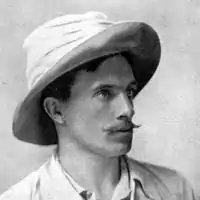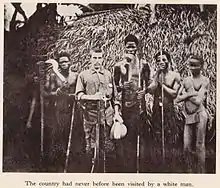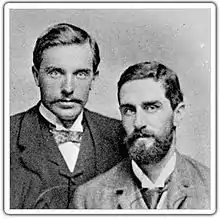Herbert Ward (sculptor)
Herbert Ward (11 January 1863, London – 5 August 1919, Neuilly-sur-Seine) was a British sculptor, illustrator, writer and African explorer. He was a member of Henry Morton Stanley's Emin Pasha Relief Expedition and became a close friend of Roger Casement while they were working in the Congo Free State. Ward later became a sculptor and lived in France. He was awarded the Croix de Guerre,[1] was twice mentioned in dispatches in World War I, was an officer of the Légion d'Honneur[2] and a member of the Royal Society of British Sculptors.[3]

Early life
He left Mill Hill School at the age of 15 and travelled to New Zealand, spending the next three years in New Zealand and Australia. He was "in turn kauri-gum digger, coal and gold miner, stock-rider, circus performer and sail-maker".[4] He then spent a year as a cadet with the British North Borneo Company, but a bout of malaria forced him to return to England.
In the Congo

In 1884, Ward met Stanley in London, when he was interviewed for a post as an officer in the new Congo Free State. Stanley recommended Ward for a position, and he spent the next two years working on the upper and lower Congo River, where he first met Roger Casement, who was working on construction of a railroad to bypass the cataracts of the lower river. After being replaced by a Belgian officer, Ward joined the Sanford Exploring Company.
In March 1887, having left the Sanford Company, Ward was returning to England when he again encountered Stanley, who was assembling the Emin Pasha relief expedition. Stanley appointed Ward as a lieutenant and placed him under the command of Major Edmund Barttelot in the expedition's rear column. Stanley left the rear column, consisting of 250 porters and five officers, in June 1887, saying "I shall find you here in October when I return." Because of Stanley's delays, the rear column remained at Yambuya by the Aruwimi River for the next 14 months, rather than 4. By that time, two of its officers and more than 100 of its porters had died.[4]
An accomplished big game hunter, Ward was known in Bangala as Nkumbe, "the black hawk." He was also referred to as Mayala Mbemba, "the wings of an eagle", a tribute to a 40-mile trek he had accomplished in a single day on atrocious roads from Kimpete to Lukungu, Congo.[5]
Ward left the Congo in early 1889. He never returned but "the enchantment of Africa held him nevertheless, dominating his future, shaping and colouring his life's work – the imprint of those five years was indelible".[6]
Roger Casement

Ward first met Roger Casement in the Congo in 1884. They became close friends, a friendship which lasted 30 years, and he asked Casement to be the godfather of his youngest son. Writing in 1910, Ward says:
Imagine a tall, handsome man, of fine bearing; thin, mere muscle and bone, a sun-tanned face, blue eyes and black curly hair. A pure Irishman he is, with a captivating voice and singular charm of manner. A man of distinction and great refinement, high-minded and courteous, impulsive and poetical. Quixotic perhaps some would say, and with a certain truth, for few men have shown themselves so regardless of personal advancement.[7]
Ward helped finance Edmund Morel's pamphlet The Congo Slave State (1903) and introduced him to Casement[4] – describing Casement to Morel, Ward wrote: "No man walks this earth at the moment who is more absolutely good and honest and noble-minded".[8] He also subscribed to the Congo Reform Association, which was founded by Casement and Morel.[6]
Ward fell out with Casement when the latter traveled to Berlin at the start of World War I to solicit German help for an armed Irish uprising for independence. Ward wrote "the enormity of his action is beyond exaggeration. He is a traitor pure and simple ... I have made up my mind to turn him down forever".[6] He fulfilled his threat, refusing to sign the petition for clemency that was organised in 1916 by Arthur Conan-Doyle after Casement was condemned to death for treason. Joseph Conrad, a fellow officer with Ward of the Sanford Exploring Company[9] and a friend of Casement at that time, also refused to sign. Ward arranged for the name of his youngest son (Casement's godson) to be changed by deed poll from Roger Casement Ward to Rodney Sanford Ward.[10]
The artist

On his return to England in 1889, Ward at first made a living on the lecture circuit. As a result of his childhood friendship with Alfred Harmsworth, he also worked as a journalist. He traveled with and reported on Fridtjoft Nansen's Fram expedition[11] and the Jackson-Harmsworth Expedition.
His main ambition was to become an artist: he had already published many of the drawings and water-colours he made in Africa in Five Years with the Congo Cannibals. He became a pupil successively of Jules Lefebvre and of Seymour Lucas RA. In the 1890s he exhibited six times at the Royal Academy summer exhibition. In 1899, deciding that sculpture was where his real talents lay, he apprenticed himself to Goscombe John RA before moving permanently to work in France. He received a mention honourable in 1901 at the Salon des Artistes Français for his first sculpture, An Aruwimi Type; and in 1908 he won the salon's gold medal for Le Chef de Tribu.[12] He won another gold medal in 1910.
Theodore Roosevelt wrote of him: "There is in Paris no more interesting character than Herbert Ward ... All the mystery and the savagery and the suffering and the ugliness and the harsh beauty of the African forest come out in Mr Ward's works. Only an artist could have done what he has done, and no artist could have done it had there not lain within him the soul of a great man, a man both strong and pitiful."[13]
Ward's auction record is £50,000, set at Bonham's auction house, London, on 30 January 2019, for An Aruwimi Type, of c1901.[14]
War service

As Ward was too old to enlist in the army, he converted his family home at Rolleboise, Seine-et-Oise, into a field hospital, with 20 beds. He then served as a lieutenant with the No 3 convoy of the British Ambulance Committee, which operated under the French army at Gérardmer in the Vosges. He was wounded at the front and mentioned in dispatches in 1915 and awarded the Croix de Guerre for his work removing wounded soldiers whilst under bombardment. He died, partly as a result of his injuries, in August 1919.[4]
Family
Ward was a nephew of the taxidermist Rowland Ward. His father Edwin Ward was also a taxidermist. His grandfather, Henry Ward, travelled with John James Audubon on his 1831–32 collecting visit to South Carolina and Florida.[15]
After returning from the Congo, in 1890 Ward married an American, Sarita Sanford (1860–1944), daughter of Charles Henry Sanford (1840–1928), a wealthy financier. They had five children:
- Sarita Enriqueta (1891–1985), wife of Sir Colville Barclay and of Robert Vansittart, 1st Baron Vansittart.
- Frances (1893–1988), wife of Sir Eric Phipps.
- Charles Sanford (1896–1916), killed on the Western Front at Neuve Chapelle serving as a lieutenant with the Royal Warwickshire Regiment.[16][17]
- the Rev Herbert Sanford (1898–1987), joined the Royal Flying Corps aged 17[18] and was shot down over the western front, later escaping to Switzerland.
- Rodney Sanford (né Roger Casement) (1901–1922).
Ward is buried in the Père-Lachaise cemetery in Paris.[19]
Bibliography
_(14803504493).jpg.webp)
Published works by Herbert Ward:
- Five Years With the Congo Cannibals, Chatto & Windus, 1891.[20]
- My Life With Stanley's Rear Guard, CL Webster, 1891.[21]
- A Voice from the Congo, Scribner & Sons, 1910[22] (French translation published as Chez les Cannibales de l'Afrique Centrale, Plon, Paris, 1910).
- Mr Poilu: Notes & Sketches with the Fighting French, Hodder & Stoughton, 1916.[23]
Publications about or featuring Herbert Ward:
- North Borneo: Explorations and Adventures on the Equator, Frank & Joseph Hatton, 1886.
- Herbert Ward et l'âme de la race noire, Francis de Miomandre, in L'Art et les artistes, Paris, 1912.
- The Arm-chair at the Inn, Francis Hopkinson Smith, Scribner & Sons, 1912.
- A Valiant Gentleman; being the biography of Herbert Ward, artist and man of action, Sarita Ward, Chapman & Hall, 1927.
- Herbert Ward: artiste et homme d'action, Sarita Ward, La Revue Mondiale, Paris, 1931.
- Herbert Ward, Armand Dayot, in the Dictionnaire biographique des artistes contemporains, vol iii, Paris, 1934.
- In Limbo: the Story of Stanley's Rear Column, Tony Gould, Hamish Hamilton, 1979.
- Valiant Gentlemen, historical novel by Sabina Murray, Grove/Atlantic, 2016.[24]
Representation in other media
- Ward also features as a character in Simon Gray's play The Rear Column (1978), and in a film version of the play directed by Harold Pinter in 1980.[25] Ward's character was played by Simon Ward in the stage and film versions.
Collections

Ward's works can be found in public collections including the following:
- The Smithsonian Institution[26]
- The National Museum of Wales[27]
- The Royal Museum for Central Africa, Tervuren, Belgium[28]
- Mill Hill School, London – Grief, given by the artist
- The Library of Congress[29]
- Le Musée des Beaux-Arts de Nantes[30]
- The Johannesburg Art Gallery
- Le Musée du Luxembourg, Paris
- Le Musée d'Orsay, Paris[31]
References
- The Straits Times 11 August, 1919
- "Ward's Légion d'Honneur award certificate". 4 May 2015.
- The Mapping of Sculpture website.
- Tony Gould: In Limbo
- Frank McLynn: Hearts of Darkness: the European Exploration of Africa, p 330, Hutchinson, 1992
- Sarita Ward: A Valiant Gentleman
- Herbert Ward: A Voice from the Congo, p233
- Martial Frindéthié: Francophone African Cinema: History, Culture, Politics and Theory
- Biographie Coloniale Belge, vol 1, col 958
- The London Gazette, 21 November 1916
- Biographie Coloniale Belge, col 956–961
- Bryham Parsons: Pot-pourri Parisien, ch 18
- Theodore Roosevelt on Herbert Ward, Theodore Roosevelt website
- Herbert Ward sale at Bonham's, London, January 2019
- Richard Rhodes: John James Audubon: the making of an American, p349
- Charles Ward on the Loos Memorial
- Alumni of Christchurch, Oxford Archived 2012-08-24 at the Wayback Machine
- An Erratic Odyssey, Rev Herbert Ward, p10-12
- Funeral of Mr Herbert Ward, The Times, 11 August 1919, p9
- Five Years with the Congo Cannibals at ForgottenBooks.com
- My Life With Stanley's Rear Guard, eBook online from the Library of Congress
- A Voice from the Congo, eBook online from Connecticut University library
- Online excerpts from Monsieur Poilu
- review of Valiant Gentlemen, Washington Post, October 2016
- Simon Gray's The Rear Column
- Herbert Ward collection catalogued
- The Idol Maker by Herbert Ward
- "Herbert Ward's Making Fire in the Royal Museum of Central Africa". Archived from the original on 20 October 2016. Retrieved 2 November 2017.
- The Forest Lovers in the Library of Congress
- Herbert Ward's Le Sorcier in the Musée des Beaux Arts of Nantes
- Herbert Ward in the Musée d'Orsay, Paris
External links
 Media related to Herbert Ward (sculptor) at Wikimedia Commons
Media related to Herbert Ward (sculptor) at Wikimedia Commons- Works by or about Herbert Ward at Internet Archive
- Brief biography of Herbert Ward on the Mapping of Sculpture website
- Archive Herbert Ward, Royal Museum for Central Africa
